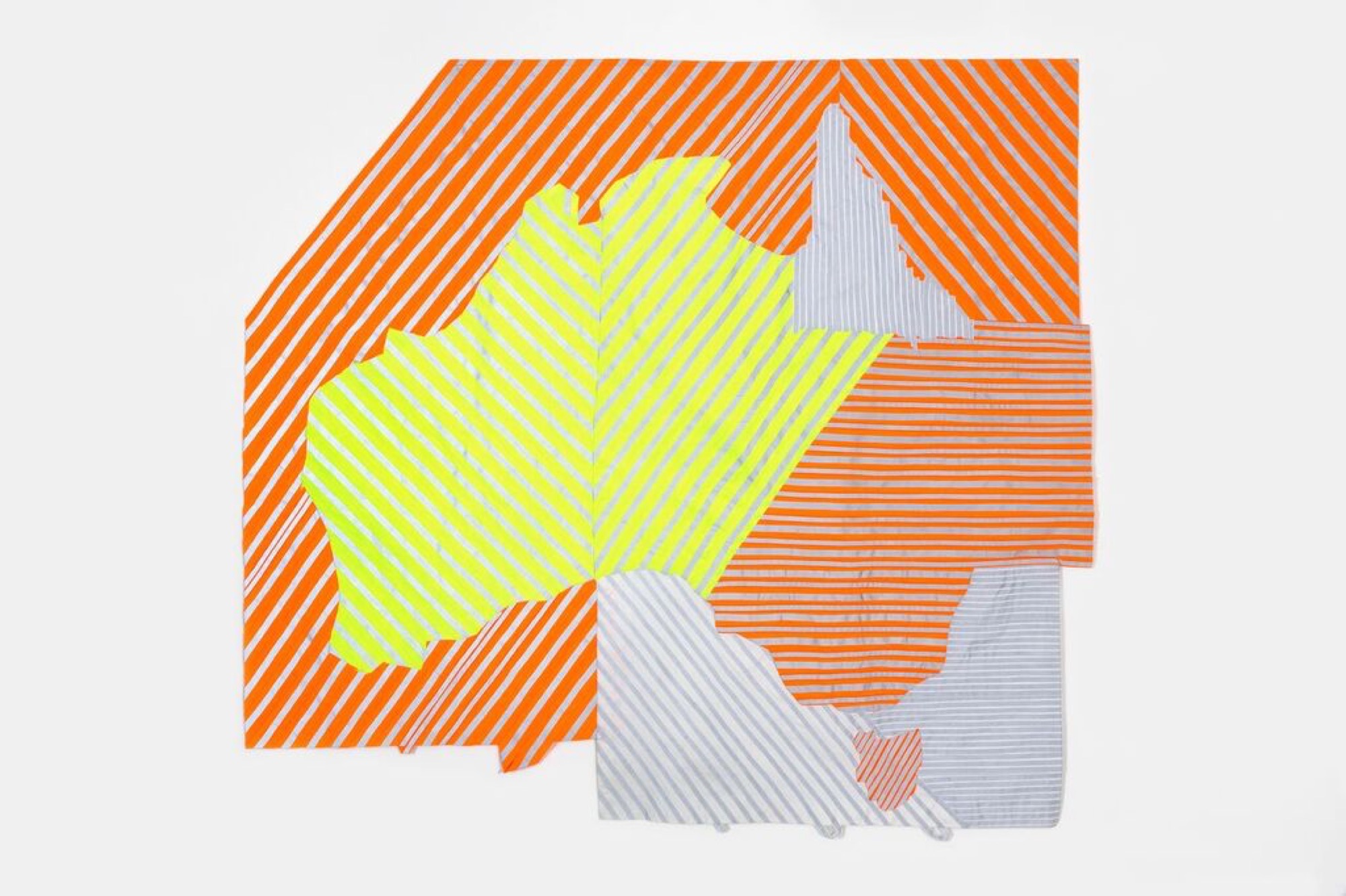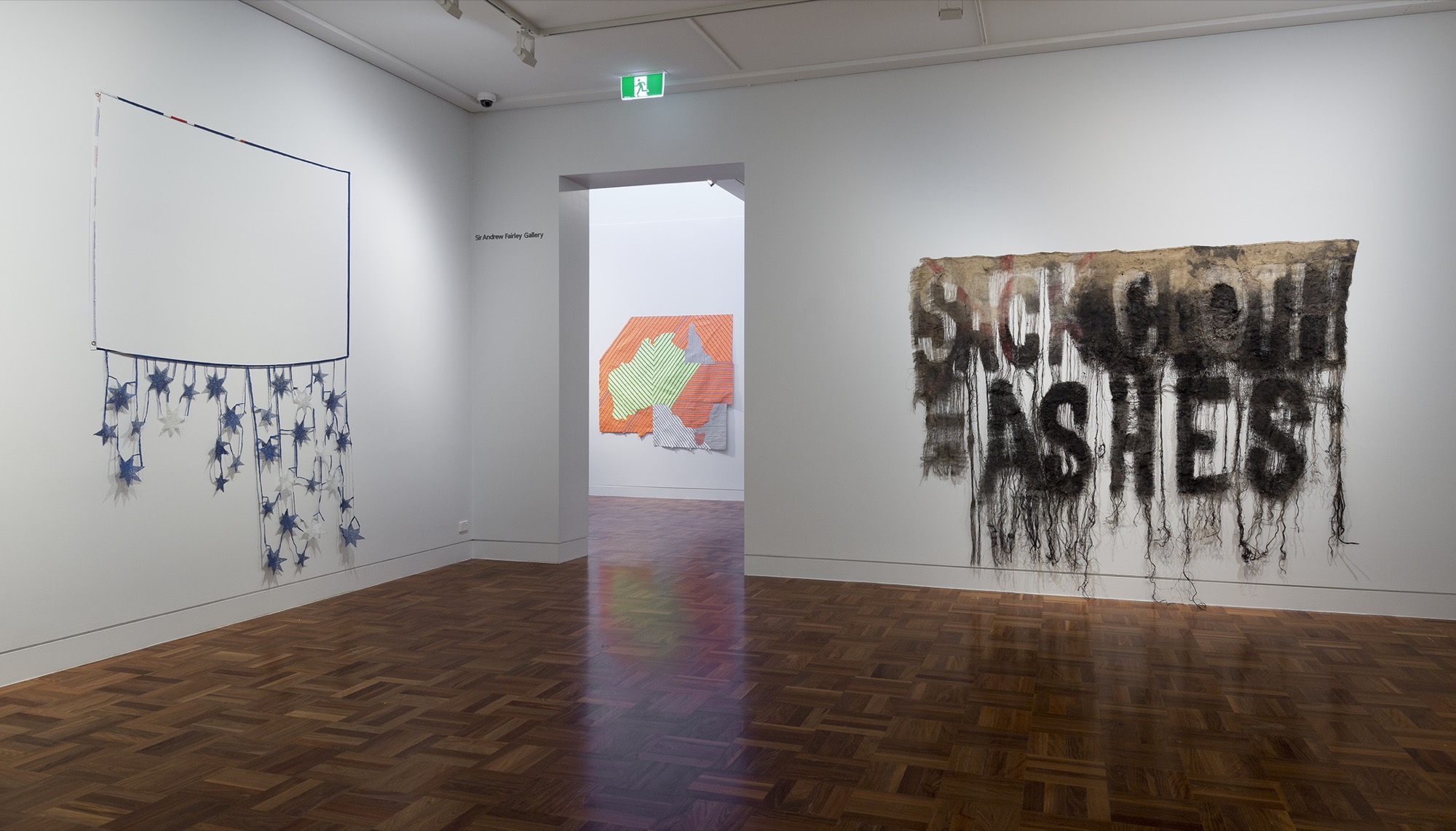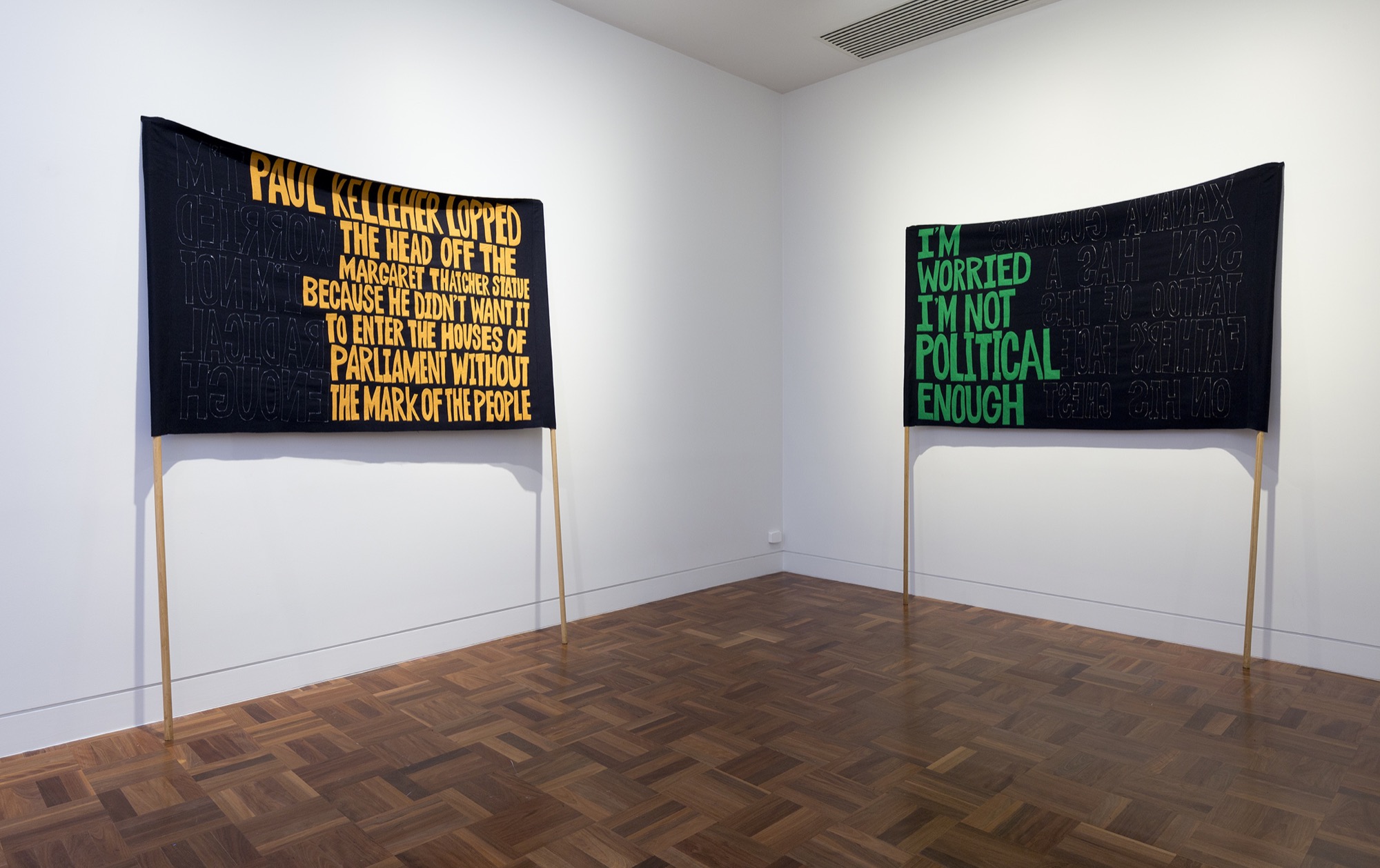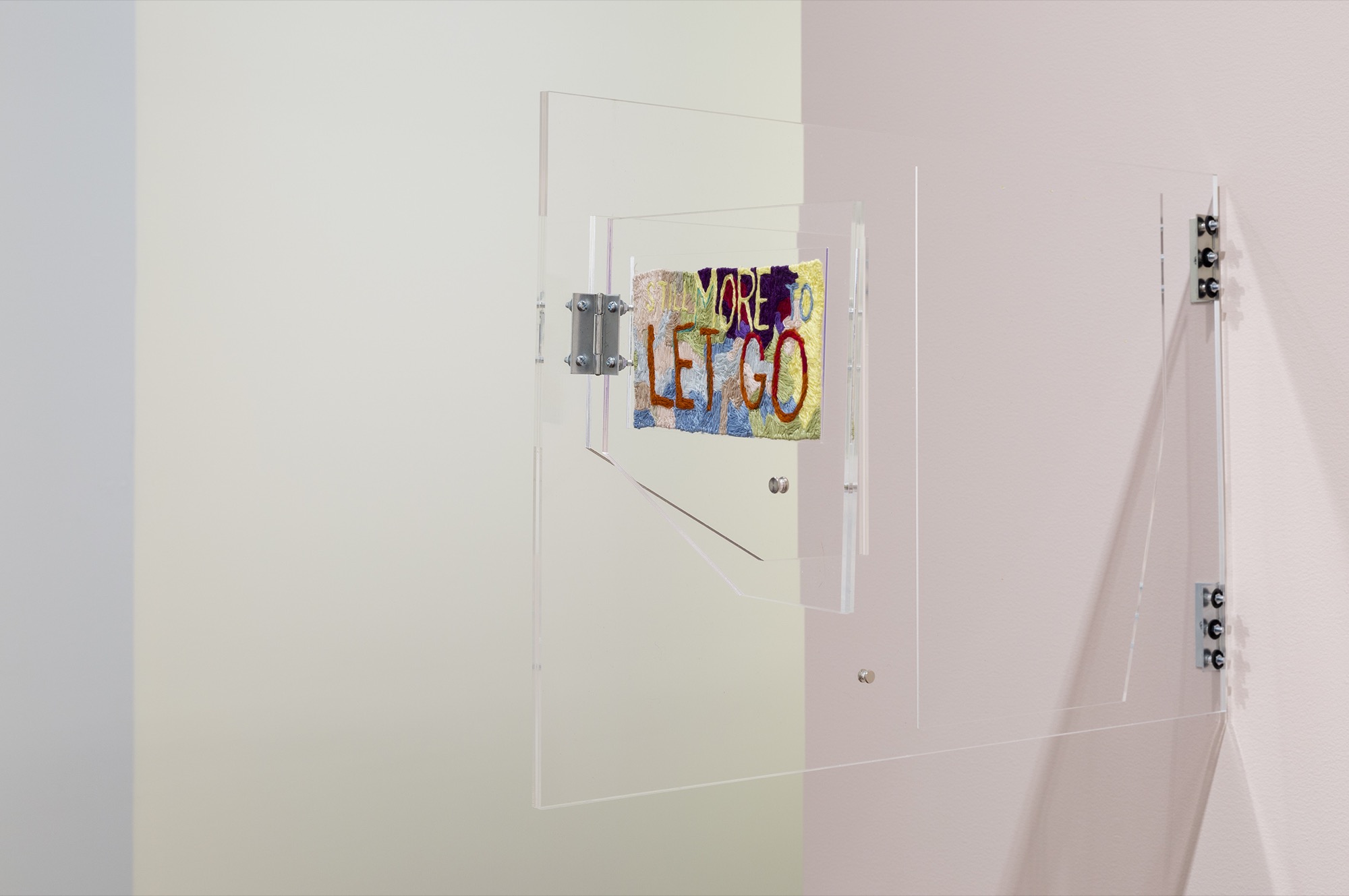I hope you get this: Raquel Ormella
Tim Alves
Raquel Ormella’s artworks have been included in a number of thematic exhibitions exploring the relationships between art and activism in recent years; examples include Direct Democracy, at MUMA in 2013 and See You at the Barricades, at AGNSW in 2015. These exhibitions showed her series of trade union style banners I’m Worried This Will Become a Slogan, 1999–2009, and her series of “reworked” flags like This Dream, 2013. The banners are made using felt letters stitched onto wool. On the one side, they describe an act of protest carried out by an individual activist, and on the other, they convey an anxiety that is ironically expressed in a slogan like: “I’m worried I’m not radical enough”. They lean against walls on dowel supports, so that one side can’t be seen and only their stitching indicates that there is more text on the other. The artwork’s sentiments combining anxiety and dark irony convey a general atmosphere that came about during the 2007–08 financial crisis when governments were forced to bail out investment banks. This Dream entangles nylon flags of Australia, Nauru and Papua New Guinea. The fabric has been snipped away to leave herringbone and pokerwork patterns and a message: “this dream on the other side of the world”. The caustic allusion to the Australian Government’s policy of processing asylum seekers in offshore detention centres is clear. Nevertheless, the exhibitions that included Ormella’s work were self-consciously questioning the assumed efficacy of such polemics in art. Influenced by new institutionalism, agonistic theories of democracy and dilemmas about the forms of direct action used by anarchist, environmentalist and alter-globalisation movements, Ormella and the other artists in these exhibitions seemed to be reasserting art’s capacities to engage with activism. They may have been protesting the bailout of banks and the crimes of Manus, but at the same time Ormella and company were broadening the scope of their engagement by foregrounding the open-ended, and thus aesthetic, character of their politics.

Other reworked Australian flags exhibited in I Hope You Get This at Shepparton Art Museum (SAM) include Return to the Beginning and New Constellation #1, both 2013. The artist guts their designs leaving only a thin rectangular outline. Numerous stars collapse out of the frame tethered by navy strands—the Southern Cross hanging upside-down. Not all Australians identify with these Christian symbols on the flag, and Ormella’s gesture reminds us that the constellation hangs whichever way in the night sky. (These stars also form the constellation of Bunya the possum, for indigenous people living around Melbourne and Shepparton.) Commentators, including Lisa Havilah and Kyla McFarlane, have made associations between protest and the destruction of flags, and viewed Ormella’s deconstruction as politically creative—compared to the spectacle of it draped around the shoulders of racist mobs in Cronulla. However, recent artworks like Golden Soil #3, 2016, which is a map of Australia made of hi-vis fabric, revisit the subject matter of the flags. While celebrating the labour of extracting resources commodities, these artworks suggest even more strongly than before that these flags are about territory, nation and state. What’s more, the flags evoke the way some felt about the sovereignty of the state in that moment. In 2013, politically minded people still felt anxious that democratic states and civic society were being eroded by globalised economies. Today we surely feel far more ambivalent about the state and the threats it faces. The most recent reworked flag in the survey Wealth for Toil #5, 2017–18 hangs in blackened tatters, expressing this feeling. I Hope You Get This at SAM is a compelling survey because it brings out the historical responsiveness and specificity of Ormella’s work.

This historical specificity is similarly recognisable in Ormella’s Wild Rivers: Cairns, Brisbane, Sydney, 2008, four electronic white boards onto which are drawn images relating to environmental activist campaigns. One image depicts an office space inhabited by the Wilderness Society in the midst of a campaign to protect the ecosystems of the Cape York Peninsula from exploitive land use under the 2005 Wild River Legislation (Qld). The space is cluttered with the visual ephemera associated with the campaign. Another image reproduces photographer Kerry Trapnell’s aerial shot of the Wenlock River near the Gulf of Carpentaria (north of Rio Tinto’s Weipa bauxite mine). Ormella’s use of white boards as the support for these images gives activism an unexpectedly bureaucratic character. A decade ago people were questioning assumptions about activism in a productive way. Sociologist James Jasper unpacked some of the sophisticated strategies activists use to gain leverage with the media and governments. And this critical engagement with activism was manifest in art. Artist Hito Steyerl perhaps best expressed the synergy of art and activism in 2002 when she claimed that activism is articulated through a series of interrelated and contradictory demands, actions and symbols, and for that reason it is a good rubric to apply to art. The picture of the Wilderness Society office on Ormella’s electronic white board is loaded with visual material including logos, slogans and an image of a spotted cuscus. This visual material developed by activists has numerous commonalities with art, of course, not least of which is its precarity in today’s saturated media environment. By the time of Ormella’s reworked flags, 2013, the Newman Government had come to power, repealing the Wild River Legislation in 2014—underlining the precarity of the gains activists make.

The freestanding electronic white boards on their casters allow viewers to see that there are images on both sides, and I Hope You Get This at SAM emphasises that this double-sidedness is a distinctive formal motif in Ormella’s practice. The motif has precedents in art history, particularly in conceptual practices. For instance, Michael Snow’s video installation Two Sides to Every Story, 1974, makes use of both sides of a thin screen to project a film. Viewers have to walk around the installation to see both sides. However, in an interview Ormella dismisses associations with these types of conceptual practices. In the same interview, she mentions an early artwork entitled While Sleeping where she drew film stills on the backs of postcards from Spain. While this artwork isn’t included in I Hope You Get This, another series, All These Small Intensities, 2017–18, is also prominently double-sided, and they share the intimate scale of a postcard. These are improvised, embroidered, text-based works. They stitch such poetic phrases as “peak loss peak acquisition/let it go”, “#someone else’s leftovers #dead aunts”, “skill set meets feminist politic”, “one indecision after another” and “still more to let go”. The phrases speak to managing collections of potential art materials by acquiring, saving, value adding and alienating. Practical and sentimental dilemmas of sedentary life are stated in colourful thread; “palette hoarder” uses cream, yellow, orange, pink, purple, blue and green. As a counterpoint to the activism associated with the banners and flags in the survey, the embroideries are familial, personal and loosely autobiographical. (That’s not saying they’re not political). They continue a post-feminist interest in craft as an antithesis to the gender biases inherent in the prestige of certain mediums, namely painting and sculpture. And in this frame of mind, they rethink the research of provenance, commonly associated with the same prestige mediums. The texts hint at the origin of the set of threads used to make the embroidery. In the survey they are displayed on Perspex sheets attached by hinges, like pages in a book.

The fourth quarter of this survey explores Ormella’s avian interests, especially twitching—bird spotting. This section displays pages of illustrated field guides—like Brian Coates’ Birds of New Guinea and the Bismarck Archipelago, 2001—with annotations on Post-its. Issues of the artist’s zines about bird spotting in Japan, planting natives in Launceston and eradicating introduced myna birds, “junk birds”, in Canberra are available. Colourful linear drawings depict the geo-political regions of Indonesia, PNG and Northern Australia overlayed with migratory bird flyways. By inference, they link back to the regional political struggles expressed in This Dream: struggles over the movement of people. These iterations of Ormella’s practice make explicit that the theme of the human impact on the world’s climate and environment is subtly present in many of her other artworks. I Hope You Get This at SAM demonstrates the breadth of Ormella’s practice. Like many artists today, she works through a range of media and conceptual terrains, but the survey brings out continuities across her distinctive approaches; relationships between stitching and sewing, activism and politics; an interest in the reverse side; and her sense of history happening.

Tim Alves is a writer and a sessional teacher at Monash University.
Title image: Raquel Ormella, This Dream, 2013, nylon, 150 x 210 cm. Art Gallery of New South Wales, Sydney. Purchased: Rudy Komon Memorial Fund, 2013. )


